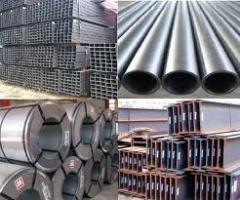Iron and steel products
| Infobox on Iron and steel products | |
|---|---|
| Example of Iron and steel products |  |
| Facts | |
| Origin | - |
| Stowage factor (in m3/t) | - |
| Humidity / moisture | - |
| Ventilation | - |
| Risk factors | See text |
Iron and steel products
Description / Risk factors
Iron and steel products
These products, broadly speaking, may be divided into two categories and they are:
a) material in the hot rolled condition which may be recognized as being blue/black in colour, which is the mill scale;
b) the cold rolled products which is the hot rolled product which has been cleaned of the mill scale and reduced in thickness by cold rolling, and this product is recognizable as being shiny and silver in colour.
In their hot rolled form most countries and industries accept that fresh water rust is not very detrimental to the product and this is because in nearly all applications hot rolled steel will be cleaned during or after fabrication. However, contact with sea water and certain other impurities, e.g. wet fertilizer, can be very detrimental inasmuch as by reason of its aggressive nature the surface of the material will become pitted and eroded.
Cold rolled steel, on the other hand, will become damaged by reason of contact with water in any form as same will readily rust.
Rust should be removed by a process compatible with the intended end use of the product. If acid-based pickling solutions are used, the surface must be adequately washed and neutralised after their application. Freshly cleaned steel surfaces will rust quickly unless protected by either a chemical or, more usually for temporary protection, with a suitable oil, grease or wax film.
Steel products may be protected from corrosion at the mill by a range of coating methods, prior to packing for shipment. These methods include, as the simplest, the application of oil films or primer coats of paint, and may include chemical surface conversion processes involving phosphating. In all cases there is a risk of rusting of the product if these applied films are damaged and penetrated.
The following table is a brief outline of the nature of steel products shipped and common ‘industry standard’ means of protection:
| Product and surface condition | Relative humidity |
| Steel sections and plates, with good 'mill finish' or cleaned and primed. | Prevention of direct moisture contact by e.g. sheeting. |
| Strip in coils, clean, active surfaces, possibly passivated | Moisture resistant coil wrapping, possibly oil firm |
| Precision strip, wire. Clean active surfaces, thin section products not tolerant of corrosion attack | Oil film, moisture resistant/inhibiting wrapping, coil or multiple coil containers |
| Bright (reeled, peeled, turned, ground or drawn) bar and flat stock. Clean, active surfaces, possible oil coated during processing | Oil or wax film, moisture resistant/inhibiting bundle wrapping and sleeving |
| Machinery, machined components. Clean surfaces machined to fine tolerances | Oil, grease or wax films, inhibiting wrapping, moisture resistant shrink cladding for pallets or lined crates |
Mild steel rods
Mild steel reinforcing rods, bundles with wire ties, are usually shipped as straight, but subject to length shipment facilities or customer requirement can be ‘once folded’.
By breaking of ties, unsatisfactory stowage, rough handling, faulty slinging, etc., rods can become twisted and inter-mixed, bent, etc. Straightening can be effected in several ways, but the operation can best be done by using a series of rollers/dies. In many instances it could be more economical to cut out severe kinks and produce shorter but commercially acceptable lengths.
Stainless steel
The main cause of damage is physical deformation and/or scratching. Other than in the hot rolled condition all finished stainless steel products should be paper interleaved. Fretting is a common surface defect which is generated by surface friction and shows up as a roughened patch, normally not more than 5 cm across.
Stainless steel is not stainless and surface corrosion may occur if the goods are wetted or contaminated. Using the B.S.I. grades 300 series, at 316 or higher only very abnormal circumstances will corrode the surface during a transit of, say up to 12 weeks, below 316 corrosion is possible in a normal voyage of six days or more. Type 304 and lower is very susceptible to oxidation if salt water is the contaminant. Stainless steel coils and sheet are amongst the most expensive of bulk traded steel products. They are used an application where the surface finish is of particular importance and even slight mechanical damage or staining can lead to the downgrading or rejection of a delivery against its end application. Much of the product is used to make pressed and formed components, so that coil edge and end or sheet side and corner damage can again incur penalties, in terms of reduced yields and difficulties in feeding into presses. Sheets are usually packed flat and crated to provide protection against edge damage, bending and indentation. Occasionally sheets are found which do not lie flat when the pack is opened. If the condition of the packing shows that this could not have resulted from mechanical damage during shipment, then the cause is most probably poor ‘shape’ of the strip arising during its manufacture.











